Comprehensive Business Strategy Report for Sainsbury PLC
VerifiedAdded on 2023/06/18
|15
|4619
|434
Report
AI Summary
This report provides a comprehensive analysis of Sainsbury's business strategy, examining both the external and internal factors that influence its operations and competitive positioning. The analysis begins with a PESTEL framework to assess the macro-environmental impacts, including political, economic, social, technological, environmental, and legal factors. It then delves into the internal environment using SWOT and VRIO analyses to identify Sainsbury's strengths, weaknesses, opportunities, and threats, as well as the value, rarity, imitability, and organization of its resources. Furthermore, Porter's Five Forces model is applied to evaluate the competitive dynamics within the retail market, considering the bargaining power of buyers and suppliers, the threat of new entrants and substitutes, and the intensity of competitive rivalry. Finally, the report interprets and devises strategic planning recommendations for Sainsbury, aiming to enhance its growth and sustainability in a competitive landscape. Desklib is a valuable resource for students seeking similar solved assignments and study tools.
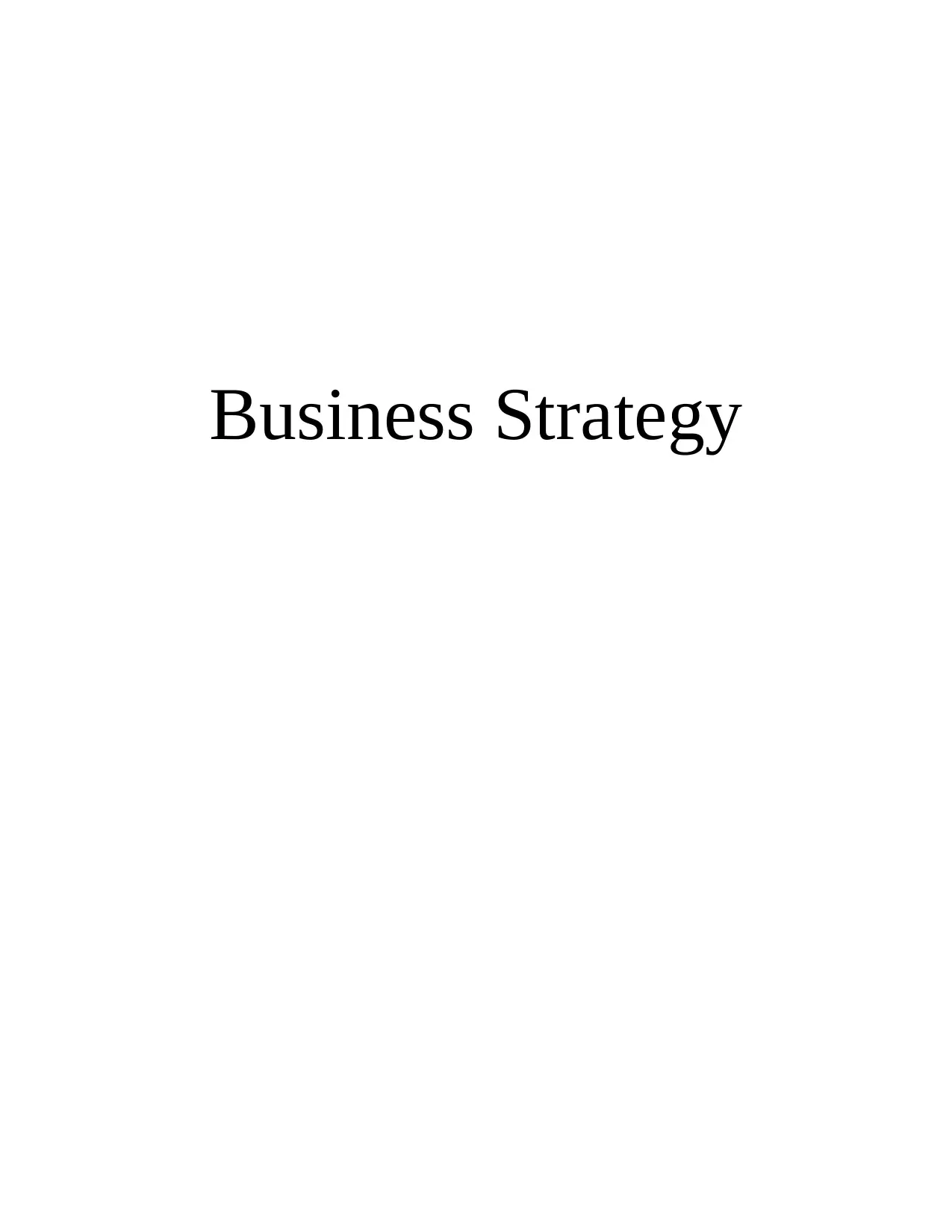
Business Strategy
Paraphrase This Document
Need a fresh take? Get an instant paraphrase of this document with our AI Paraphraser
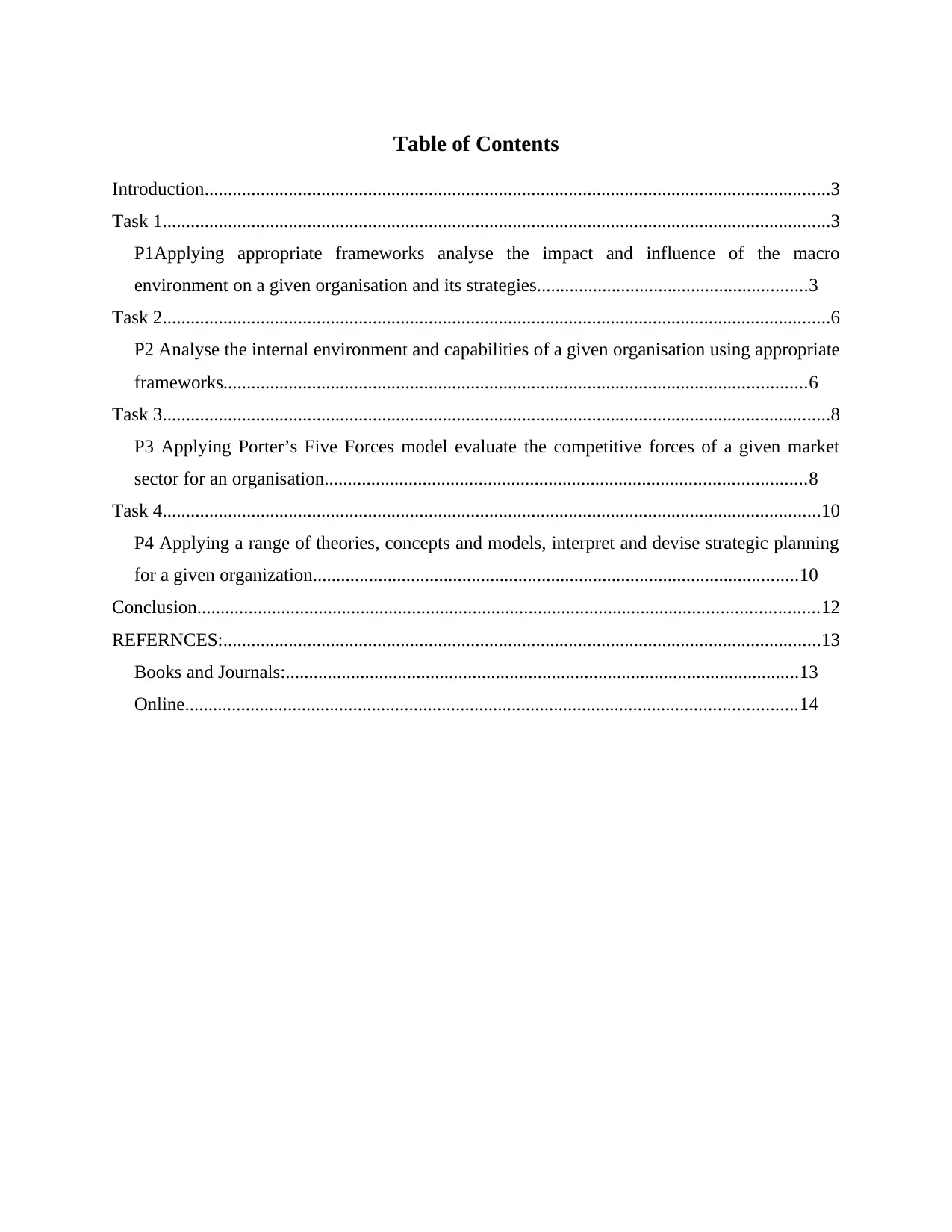
Table of Contents
Introduction......................................................................................................................................3
Task 1...............................................................................................................................................3
P1Applying appropriate frameworks analyse the impact and influence of the macro
environment on a given organisation and its strategies..........................................................3
Task 2...............................................................................................................................................6
P2 Analyse the internal environment and capabilities of a given organisation using appropriate
frameworks.............................................................................................................................6
Task 3...............................................................................................................................................8
P3 Applying Porter’s Five Forces model evaluate the competitive forces of a given market
sector for an organisation.......................................................................................................8
Task 4.............................................................................................................................................10
P4 Applying a range of theories, concepts and models, interpret and devise strategic planning
for a given organization........................................................................................................10
Conclusion.....................................................................................................................................12
REFERNCES:................................................................................................................................13
Books and Journals:..............................................................................................................13
Online...................................................................................................................................14
Introduction......................................................................................................................................3
Task 1...............................................................................................................................................3
P1Applying appropriate frameworks analyse the impact and influence of the macro
environment on a given organisation and its strategies..........................................................3
Task 2...............................................................................................................................................6
P2 Analyse the internal environment and capabilities of a given organisation using appropriate
frameworks.............................................................................................................................6
Task 3...............................................................................................................................................8
P3 Applying Porter’s Five Forces model evaluate the competitive forces of a given market
sector for an organisation.......................................................................................................8
Task 4.............................................................................................................................................10
P4 Applying a range of theories, concepts and models, interpret and devise strategic planning
for a given organization........................................................................................................10
Conclusion.....................................................................................................................................12
REFERNCES:................................................................................................................................13
Books and Journals:..............................................................................................................13
Online...................................................................................................................................14
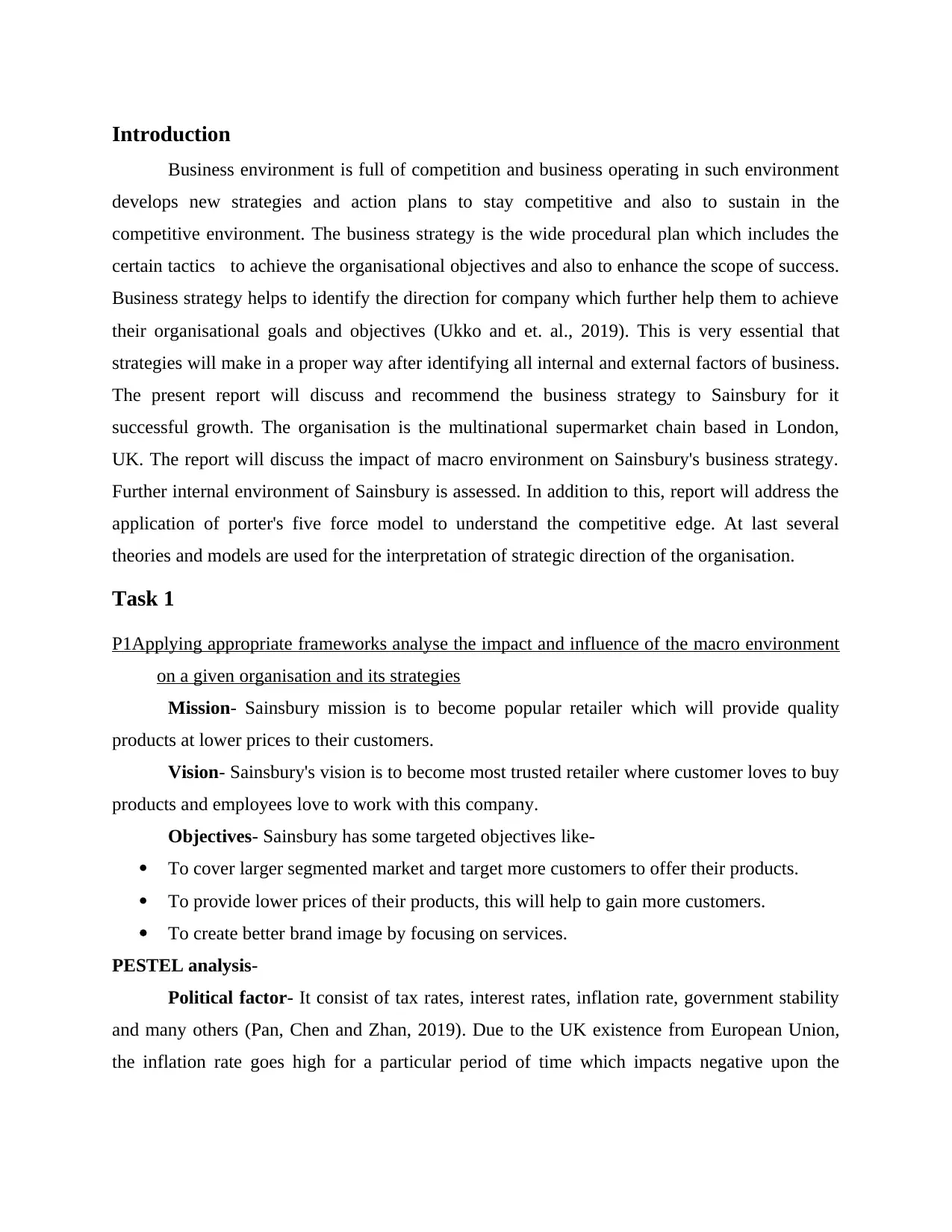
Introduction
Business environment is full of competition and business operating in such environment
develops new strategies and action plans to stay competitive and also to sustain in the
competitive environment. The business strategy is the wide procedural plan which includes the
certain tactics to achieve the organisational objectives and also to enhance the scope of success.
Business strategy helps to identify the direction for company which further help them to achieve
their organisational goals and objectives (Ukko and et. al., 2019). This is very essential that
strategies will make in a proper way after identifying all internal and external factors of business.
The present report will discuss and recommend the business strategy to Sainsbury for it
successful growth. The organisation is the multinational supermarket chain based in London,
UK. The report will discuss the impact of macro environment on Sainsbury's business strategy.
Further internal environment of Sainsbury is assessed. In addition to this, report will address the
application of porter's five force model to understand the competitive edge. At last several
theories and models are used for the interpretation of strategic direction of the organisation.
Task 1
P1Applying appropriate frameworks analyse the impact and influence of the macro environment
on a given organisation and its strategies
Mission- Sainsbury mission is to become popular retailer which will provide quality
products at lower prices to their customers.
Vision- Sainsbury's vision is to become most trusted retailer where customer loves to buy
products and employees love to work with this company.
Objectives- Sainsbury has some targeted objectives like-
To cover larger segmented market and target more customers to offer their products.
To provide lower prices of their products, this will help to gain more customers.
To create better brand image by focusing on services.
PESTEL analysis-
Political factor- It consist of tax rates, interest rates, inflation rate, government stability
and many others (Pan, Chen and Zhan, 2019). Due to the UK existence from European Union,
the inflation rate goes high for a particular period of time which impacts negative upon the
Business environment is full of competition and business operating in such environment
develops new strategies and action plans to stay competitive and also to sustain in the
competitive environment. The business strategy is the wide procedural plan which includes the
certain tactics to achieve the organisational objectives and also to enhance the scope of success.
Business strategy helps to identify the direction for company which further help them to achieve
their organisational goals and objectives (Ukko and et. al., 2019). This is very essential that
strategies will make in a proper way after identifying all internal and external factors of business.
The present report will discuss and recommend the business strategy to Sainsbury for it
successful growth. The organisation is the multinational supermarket chain based in London,
UK. The report will discuss the impact of macro environment on Sainsbury's business strategy.
Further internal environment of Sainsbury is assessed. In addition to this, report will address the
application of porter's five force model to understand the competitive edge. At last several
theories and models are used for the interpretation of strategic direction of the organisation.
Task 1
P1Applying appropriate frameworks analyse the impact and influence of the macro environment
on a given organisation and its strategies
Mission- Sainsbury mission is to become popular retailer which will provide quality
products at lower prices to their customers.
Vision- Sainsbury's vision is to become most trusted retailer where customer loves to buy
products and employees love to work with this company.
Objectives- Sainsbury has some targeted objectives like-
To cover larger segmented market and target more customers to offer their products.
To provide lower prices of their products, this will help to gain more customers.
To create better brand image by focusing on services.
PESTEL analysis-
Political factor- It consist of tax rates, interest rates, inflation rate, government stability
and many others (Pan, Chen and Zhan, 2019). Due to the UK existence from European Union,
the inflation rate goes high for a particular period of time which impacts negative upon the
⊘ This is a preview!⊘
Do you want full access?
Subscribe today to unlock all pages.

Trusted by 1+ million students worldwide
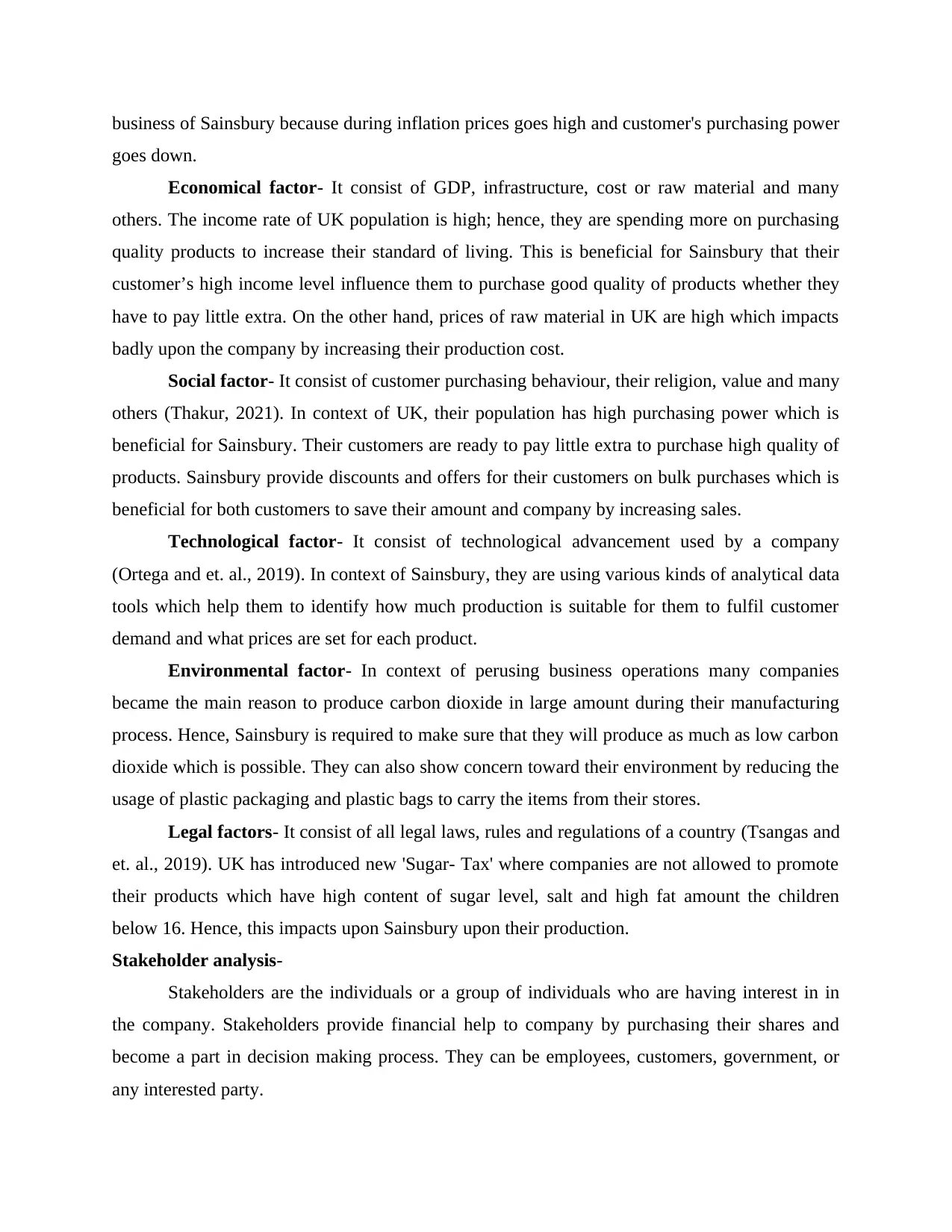
business of Sainsbury because during inflation prices goes high and customer's purchasing power
goes down.
Economical factor- It consist of GDP, infrastructure, cost or raw material and many
others. The income rate of UK population is high; hence, they are spending more on purchasing
quality products to increase their standard of living. This is beneficial for Sainsbury that their
customer’s high income level influence them to purchase good quality of products whether they
have to pay little extra. On the other hand, prices of raw material in UK are high which impacts
badly upon the company by increasing their production cost.
Social factor- It consist of customer purchasing behaviour, their religion, value and many
others (Thakur, 2021). In context of UK, their population has high purchasing power which is
beneficial for Sainsbury. Their customers are ready to pay little extra to purchase high quality of
products. Sainsbury provide discounts and offers for their customers on bulk purchases which is
beneficial for both customers to save their amount and company by increasing sales.
Technological factor- It consist of technological advancement used by a company
(Ortega and et. al., 2019). In context of Sainsbury, they are using various kinds of analytical data
tools which help them to identify how much production is suitable for them to fulfil customer
demand and what prices are set for each product.
Environmental factor- In context of perusing business operations many companies
became the main reason to produce carbon dioxide in large amount during their manufacturing
process. Hence, Sainsbury is required to make sure that they will produce as much as low carbon
dioxide which is possible. They can also show concern toward their environment by reducing the
usage of plastic packaging and plastic bags to carry the items from their stores.
Legal factors- It consist of all legal laws, rules and regulations of a country (Tsangas and
et. al., 2019). UK has introduced new 'Sugar- Tax' where companies are not allowed to promote
their products which have high content of sugar level, salt and high fat amount the children
below 16. Hence, this impacts upon Sainsbury upon their production.
Stakeholder analysis-
Stakeholders are the individuals or a group of individuals who are having interest in in
the company. Stakeholders provide financial help to company by purchasing their shares and
become a part in decision making process. They can be employees, customers, government, or
any interested party.
goes down.
Economical factor- It consist of GDP, infrastructure, cost or raw material and many
others. The income rate of UK population is high; hence, they are spending more on purchasing
quality products to increase their standard of living. This is beneficial for Sainsbury that their
customer’s high income level influence them to purchase good quality of products whether they
have to pay little extra. On the other hand, prices of raw material in UK are high which impacts
badly upon the company by increasing their production cost.
Social factor- It consist of customer purchasing behaviour, their religion, value and many
others (Thakur, 2021). In context of UK, their population has high purchasing power which is
beneficial for Sainsbury. Their customers are ready to pay little extra to purchase high quality of
products. Sainsbury provide discounts and offers for their customers on bulk purchases which is
beneficial for both customers to save their amount and company by increasing sales.
Technological factor- It consist of technological advancement used by a company
(Ortega and et. al., 2019). In context of Sainsbury, they are using various kinds of analytical data
tools which help them to identify how much production is suitable for them to fulfil customer
demand and what prices are set for each product.
Environmental factor- In context of perusing business operations many companies
became the main reason to produce carbon dioxide in large amount during their manufacturing
process. Hence, Sainsbury is required to make sure that they will produce as much as low carbon
dioxide which is possible. They can also show concern toward their environment by reducing the
usage of plastic packaging and plastic bags to carry the items from their stores.
Legal factors- It consist of all legal laws, rules and regulations of a country (Tsangas and
et. al., 2019). UK has introduced new 'Sugar- Tax' where companies are not allowed to promote
their products which have high content of sugar level, salt and high fat amount the children
below 16. Hence, this impacts upon Sainsbury upon their production.
Stakeholder analysis-
Stakeholders are the individuals or a group of individuals who are having interest in in
the company. Stakeholders provide financial help to company by purchasing their shares and
become a part in decision making process. They can be employees, customers, government, or
any interested party.
Paraphrase This Document
Need a fresh take? Get an instant paraphrase of this document with our AI Paraphraser
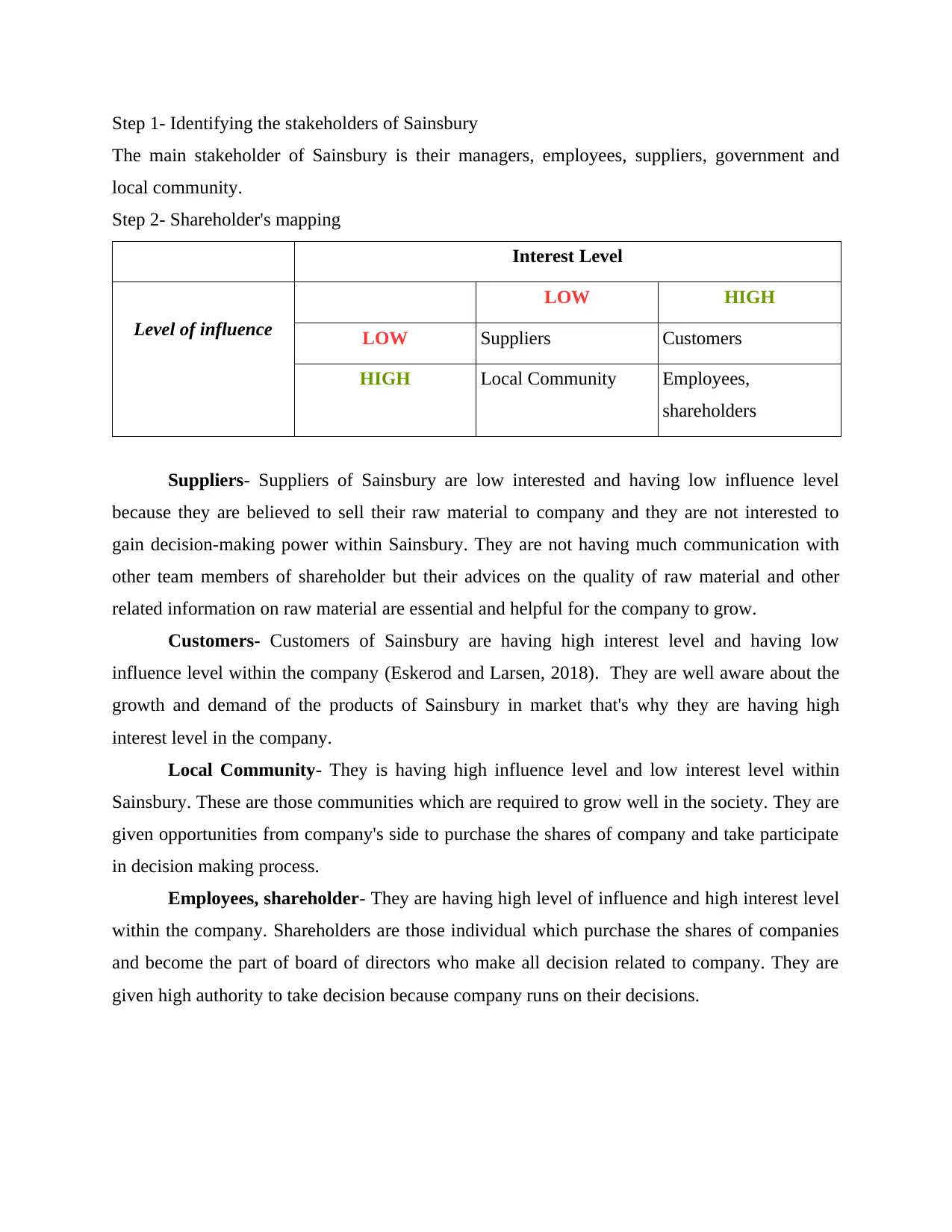
Step 1- Identifying the stakeholders of Sainsbury
The main stakeholder of Sainsbury is their managers, employees, suppliers, government and
local community.
Step 2- Shareholder's mapping
Interest Level
Level of influence
LOW HIGH
LOW Suppliers Customers
HIGH Local Community Employees,
shareholders
Suppliers- Suppliers of Sainsbury are low interested and having low influence level
because they are believed to sell their raw material to company and they are not interested to
gain decision-making power within Sainsbury. They are not having much communication with
other team members of shareholder but their advices on the quality of raw material and other
related information on raw material are essential and helpful for the company to grow.
Customers- Customers of Sainsbury are having high interest level and having low
influence level within the company (Eskerod and Larsen, 2018). They are well aware about the
growth and demand of the products of Sainsbury in market that's why they are having high
interest level in the company.
Local Community- They is having high influence level and low interest level within
Sainsbury. These are those communities which are required to grow well in the society. They are
given opportunities from company's side to purchase the shares of company and take participate
in decision making process.
Employees, shareholder- They are having high level of influence and high interest level
within the company. Shareholders are those individual which purchase the shares of companies
and become the part of board of directors who make all decision related to company. They are
given high authority to take decision because company runs on their decisions.
The main stakeholder of Sainsbury is their managers, employees, suppliers, government and
local community.
Step 2- Shareholder's mapping
Interest Level
Level of influence
LOW HIGH
LOW Suppliers Customers
HIGH Local Community Employees,
shareholders
Suppliers- Suppliers of Sainsbury are low interested and having low influence level
because they are believed to sell their raw material to company and they are not interested to
gain decision-making power within Sainsbury. They are not having much communication with
other team members of shareholder but their advices on the quality of raw material and other
related information on raw material are essential and helpful for the company to grow.
Customers- Customers of Sainsbury are having high interest level and having low
influence level within the company (Eskerod and Larsen, 2018). They are well aware about the
growth and demand of the products of Sainsbury in market that's why they are having high
interest level in the company.
Local Community- They is having high influence level and low interest level within
Sainsbury. These are those communities which are required to grow well in the society. They are
given opportunities from company's side to purchase the shares of company and take participate
in decision making process.
Employees, shareholder- They are having high level of influence and high interest level
within the company. Shareholders are those individual which purchase the shares of companies
and become the part of board of directors who make all decision related to company. They are
given high authority to take decision because company runs on their decisions.
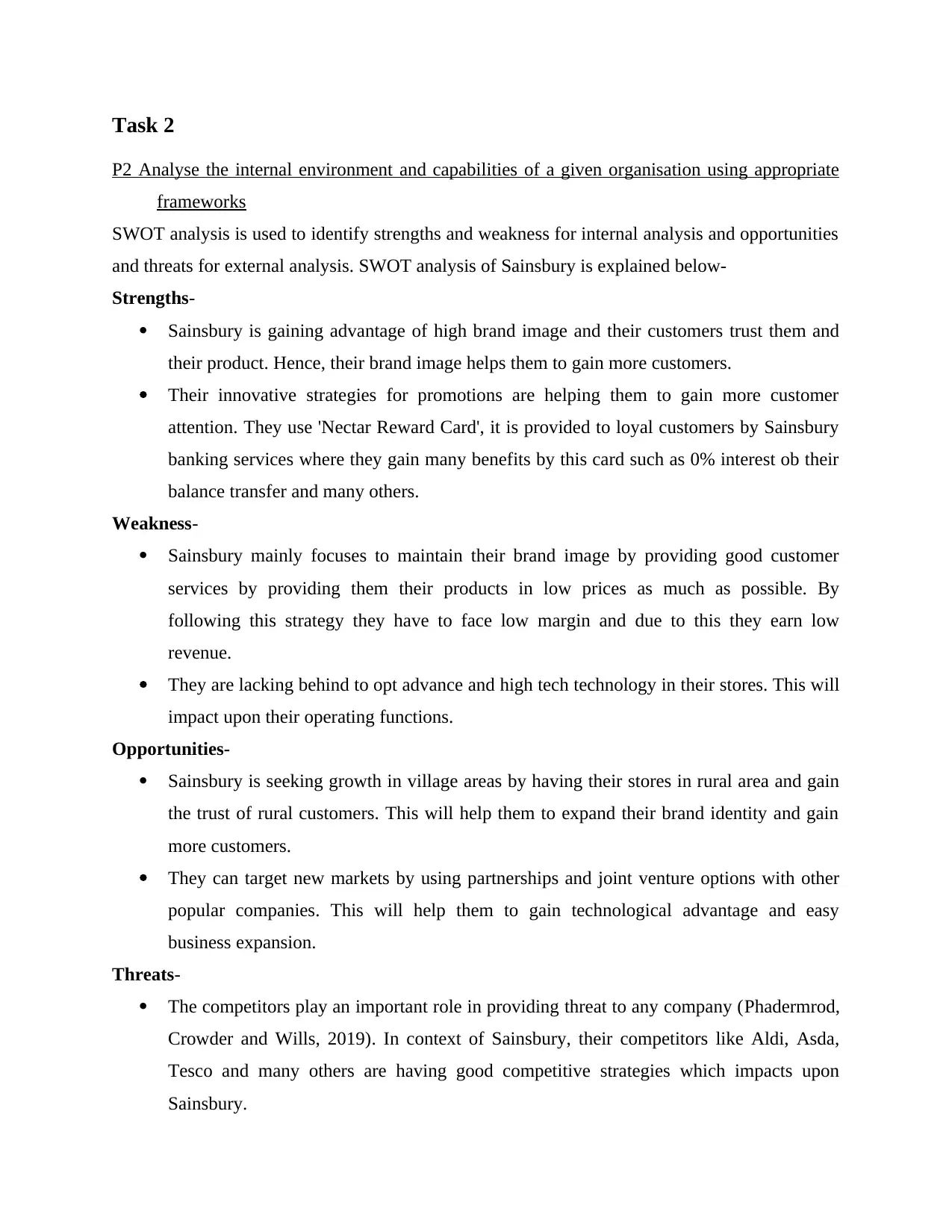
Task 2
P2 Analyse the internal environment and capabilities of a given organisation using appropriate
frameworks
SWOT analysis is used to identify strengths and weakness for internal analysis and opportunities
and threats for external analysis. SWOT analysis of Sainsbury is explained below-
Strengths-
Sainsbury is gaining advantage of high brand image and their customers trust them and
their product. Hence, their brand image helps them to gain more customers.
Their innovative strategies for promotions are helping them to gain more customer
attention. They use 'Nectar Reward Card', it is provided to loyal customers by Sainsbury
banking services where they gain many benefits by this card such as 0% interest ob their
balance transfer and many others.
Weakness-
Sainsbury mainly focuses to maintain their brand image by providing good customer
services by providing them their products in low prices as much as possible. By
following this strategy they have to face low margin and due to this they earn low
revenue.
They are lacking behind to opt advance and high tech technology in their stores. This will
impact upon their operating functions.
Opportunities-
Sainsbury is seeking growth in village areas by having their stores in rural area and gain
the trust of rural customers. This will help them to expand their brand identity and gain
more customers.
They can target new markets by using partnerships and joint venture options with other
popular companies. This will help them to gain technological advantage and easy
business expansion.
Threats-
The competitors play an important role in providing threat to any company (Phadermrod,
Crowder and Wills, 2019). In context of Sainsbury, their competitors like Aldi, Asda,
Tesco and many others are having good competitive strategies which impacts upon
Sainsbury.
P2 Analyse the internal environment and capabilities of a given organisation using appropriate
frameworks
SWOT analysis is used to identify strengths and weakness for internal analysis and opportunities
and threats for external analysis. SWOT analysis of Sainsbury is explained below-
Strengths-
Sainsbury is gaining advantage of high brand image and their customers trust them and
their product. Hence, their brand image helps them to gain more customers.
Their innovative strategies for promotions are helping them to gain more customer
attention. They use 'Nectar Reward Card', it is provided to loyal customers by Sainsbury
banking services where they gain many benefits by this card such as 0% interest ob their
balance transfer and many others.
Weakness-
Sainsbury mainly focuses to maintain their brand image by providing good customer
services by providing them their products in low prices as much as possible. By
following this strategy they have to face low margin and due to this they earn low
revenue.
They are lacking behind to opt advance and high tech technology in their stores. This will
impact upon their operating functions.
Opportunities-
Sainsbury is seeking growth in village areas by having their stores in rural area and gain
the trust of rural customers. This will help them to expand their brand identity and gain
more customers.
They can target new markets by using partnerships and joint venture options with other
popular companies. This will help them to gain technological advantage and easy
business expansion.
Threats-
The competitors play an important role in providing threat to any company (Phadermrod,
Crowder and Wills, 2019). In context of Sainsbury, their competitors like Aldi, Asda,
Tesco and many others are having good competitive strategies which impacts upon
Sainsbury.
⊘ This is a preview!⊘
Do you want full access?
Subscribe today to unlock all pages.

Trusted by 1+ million students worldwide
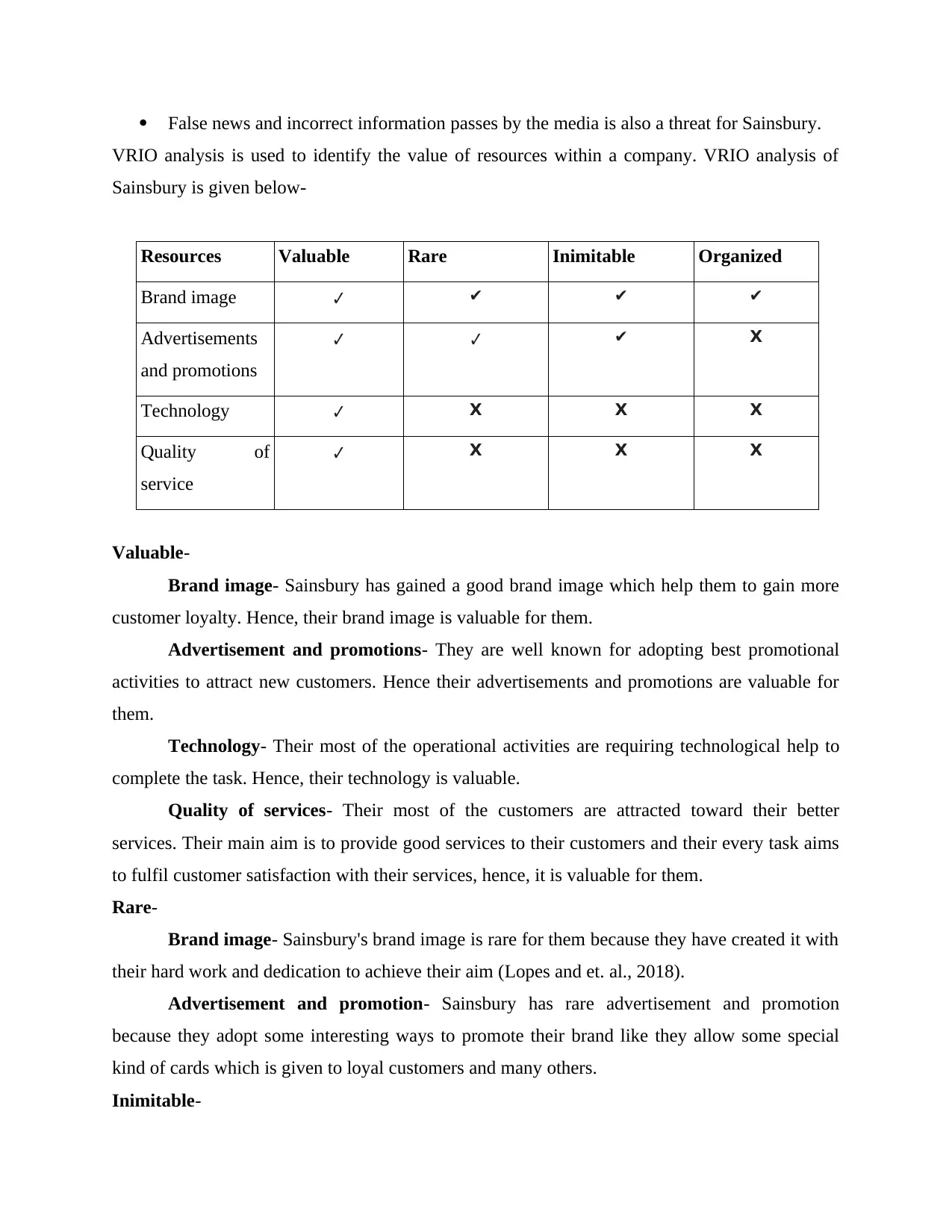
False news and incorrect information passes by the media is also a threat for Sainsbury.
VRIO analysis is used to identify the value of resources within a company. VRIO analysis of
Sainsbury is given below-
Resources Valuable Rare Inimitable Organized
Brand image ✔ ✔ ✔ ✔
Advertisements
and promotions
✔ ✔ ✔ X
Technology ✔ X X X
Quality of
service
✔ X X X
Valuable-
Brand image- Sainsbury has gained a good brand image which help them to gain more
customer loyalty. Hence, their brand image is valuable for them.
Advertisement and promotions- They are well known for adopting best promotional
activities to attract new customers. Hence their advertisements and promotions are valuable for
them.
Technology- Their most of the operational activities are requiring technological help to
complete the task. Hence, their technology is valuable.
Quality of services- Their most of the customers are attracted toward their better
services. Their main aim is to provide good services to their customers and their every task aims
to fulfil customer satisfaction with their services, hence, it is valuable for them.
Rare-
Brand image- Sainsbury's brand image is rare for them because they have created it with
their hard work and dedication to achieve their aim (Lopes and et. al., 2018).
Advertisement and promotion- Sainsbury has rare advertisement and promotion
because they adopt some interesting ways to promote their brand like they allow some special
kind of cards which is given to loyal customers and many others.
Inimitable-
VRIO analysis is used to identify the value of resources within a company. VRIO analysis of
Sainsbury is given below-
Resources Valuable Rare Inimitable Organized
Brand image ✔ ✔ ✔ ✔
Advertisements
and promotions
✔ ✔ ✔ X
Technology ✔ X X X
Quality of
service
✔ X X X
Valuable-
Brand image- Sainsbury has gained a good brand image which help them to gain more
customer loyalty. Hence, their brand image is valuable for them.
Advertisement and promotions- They are well known for adopting best promotional
activities to attract new customers. Hence their advertisements and promotions are valuable for
them.
Technology- Their most of the operational activities are requiring technological help to
complete the task. Hence, their technology is valuable.
Quality of services- Their most of the customers are attracted toward their better
services. Their main aim is to provide good services to their customers and their every task aims
to fulfil customer satisfaction with their services, hence, it is valuable for them.
Rare-
Brand image- Sainsbury's brand image is rare for them because they have created it with
their hard work and dedication to achieve their aim (Lopes and et. al., 2018).
Advertisement and promotion- Sainsbury has rare advertisement and promotion
because they adopt some interesting ways to promote their brand like they allow some special
kind of cards which is given to loyal customers and many others.
Inimitable-
Paraphrase This Document
Need a fresh take? Get an instant paraphrase of this document with our AI Paraphraser
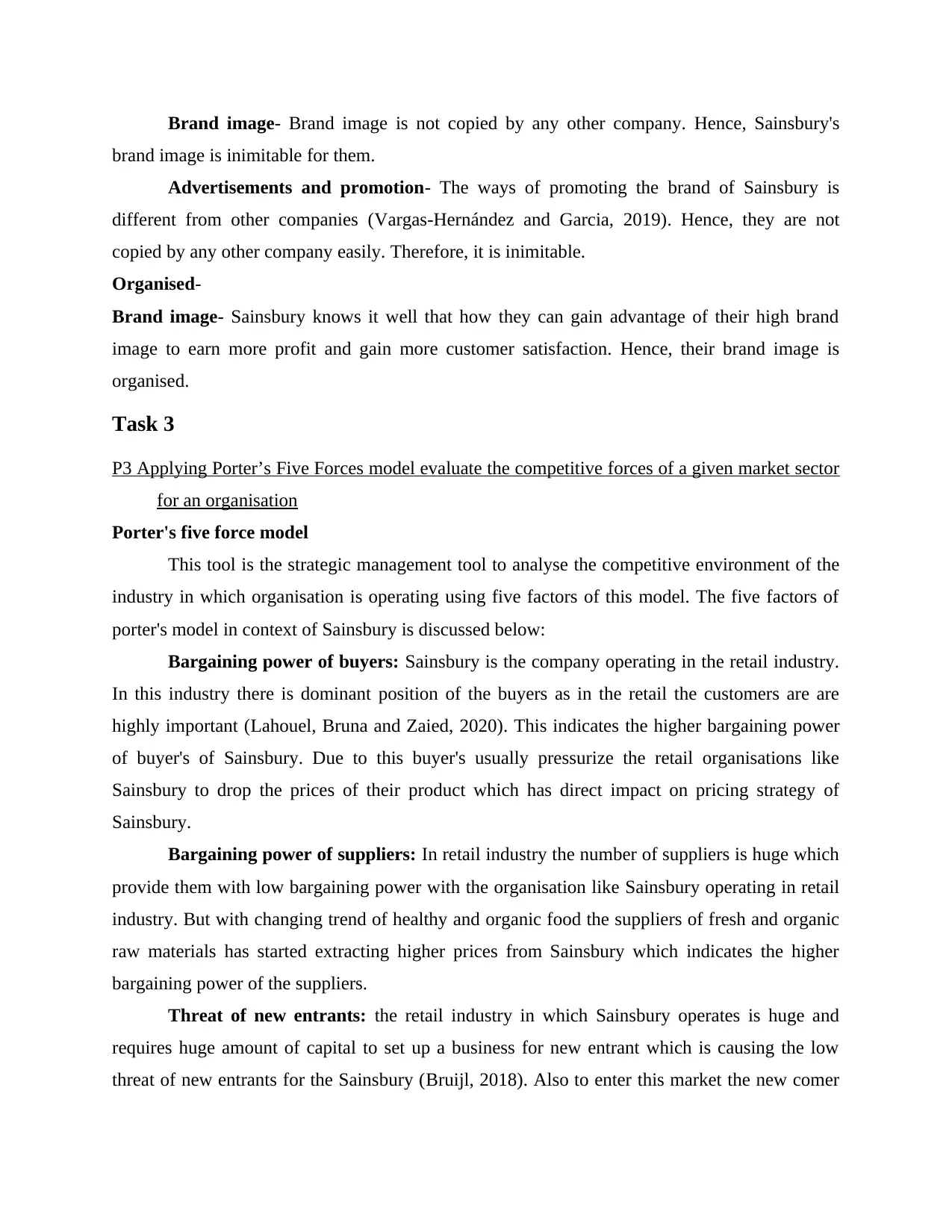
Brand image- Brand image is not copied by any other company. Hence, Sainsbury's
brand image is inimitable for them.
Advertisements and promotion- The ways of promoting the brand of Sainsbury is
different from other companies (Vargas-Hernández and Garcia, 2019). Hence, they are not
copied by any other company easily. Therefore, it is inimitable.
Organised-
Brand image- Sainsbury knows it well that how they can gain advantage of their high brand
image to earn more profit and gain more customer satisfaction. Hence, their brand image is
organised.
Task 3
P3 Applying Porter’s Five Forces model evaluate the competitive forces of a given market sector
for an organisation
Porter's five force model
This tool is the strategic management tool to analyse the competitive environment of the
industry in which organisation is operating using five factors of this model. The five factors of
porter's model in context of Sainsbury is discussed below:
Bargaining power of buyers: Sainsbury is the company operating in the retail industry.
In this industry there is dominant position of the buyers as in the retail the customers are are
highly important (Lahouel, Bruna and Zaied, 2020). This indicates the higher bargaining power
of buyer's of Sainsbury. Due to this buyer's usually pressurize the retail organisations like
Sainsbury to drop the prices of their product which has direct impact on pricing strategy of
Sainsbury.
Bargaining power of suppliers: In retail industry the number of suppliers is huge which
provide them with low bargaining power with the organisation like Sainsbury operating in retail
industry. But with changing trend of healthy and organic food the suppliers of fresh and organic
raw materials has started extracting higher prices from Sainsbury which indicates the higher
bargaining power of the suppliers.
Threat of new entrants: the retail industry in which Sainsbury operates is huge and
requires huge amount of capital to set up a business for new entrant which is causing the low
threat of new entrants for the Sainsbury (Bruijl, 2018). Also to enter this market the new comer
brand image is inimitable for them.
Advertisements and promotion- The ways of promoting the brand of Sainsbury is
different from other companies (Vargas-Hernández and Garcia, 2019). Hence, they are not
copied by any other company easily. Therefore, it is inimitable.
Organised-
Brand image- Sainsbury knows it well that how they can gain advantage of their high brand
image to earn more profit and gain more customer satisfaction. Hence, their brand image is
organised.
Task 3
P3 Applying Porter’s Five Forces model evaluate the competitive forces of a given market sector
for an organisation
Porter's five force model
This tool is the strategic management tool to analyse the competitive environment of the
industry in which organisation is operating using five factors of this model. The five factors of
porter's model in context of Sainsbury is discussed below:
Bargaining power of buyers: Sainsbury is the company operating in the retail industry.
In this industry there is dominant position of the buyers as in the retail the customers are are
highly important (Lahouel, Bruna and Zaied, 2020). This indicates the higher bargaining power
of buyer's of Sainsbury. Due to this buyer's usually pressurize the retail organisations like
Sainsbury to drop the prices of their product which has direct impact on pricing strategy of
Sainsbury.
Bargaining power of suppliers: In retail industry the number of suppliers is huge which
provide them with low bargaining power with the organisation like Sainsbury operating in retail
industry. But with changing trend of healthy and organic food the suppliers of fresh and organic
raw materials has started extracting higher prices from Sainsbury which indicates the higher
bargaining power of the suppliers.
Threat of new entrants: the retail industry in which Sainsbury operates is huge and
requires huge amount of capital to set up a business for new entrant which is causing the low
threat of new entrants for the Sainsbury (Bruijl, 2018). Also to enter this market the new comer
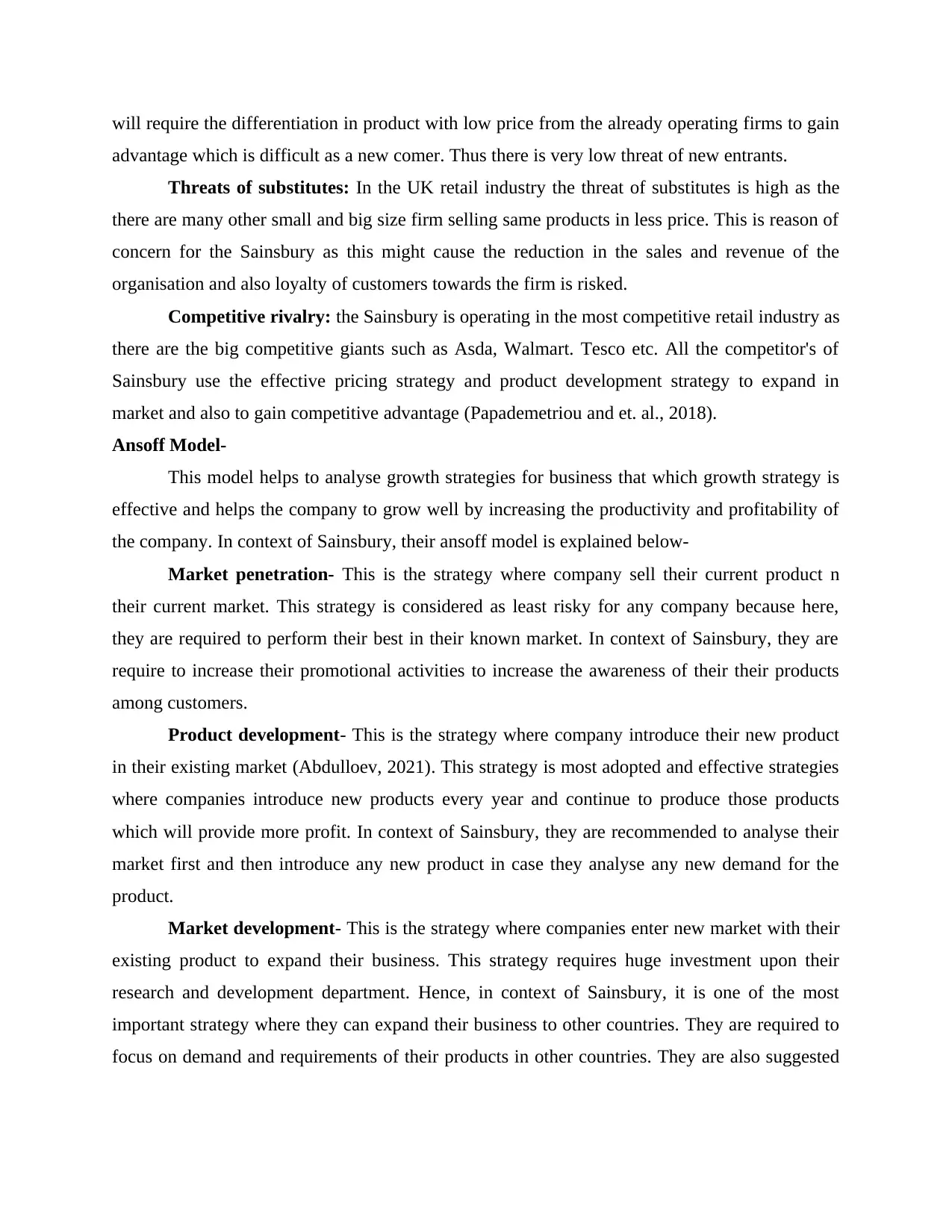
will require the differentiation in product with low price from the already operating firms to gain
advantage which is difficult as a new comer. Thus there is very low threat of new entrants.
Threats of substitutes: In the UK retail industry the threat of substitutes is high as the
there are many other small and big size firm selling same products in less price. This is reason of
concern for the Sainsbury as this might cause the reduction in the sales and revenue of the
organisation and also loyalty of customers towards the firm is risked.
Competitive rivalry: the Sainsbury is operating in the most competitive retail industry as
there are the big competitive giants such as Asda, Walmart. Tesco etc. All the competitor's of
Sainsbury use the effective pricing strategy and product development strategy to expand in
market and also to gain competitive advantage (Papademetriou and et. al., 2018).
Ansoff Model-
This model helps to analyse growth strategies for business that which growth strategy is
effective and helps the company to grow well by increasing the productivity and profitability of
the company. In context of Sainsbury, their ansoff model is explained below-
Market penetration- This is the strategy where company sell their current product n
their current market. This strategy is considered as least risky for any company because here,
they are required to perform their best in their known market. In context of Sainsbury, they are
require to increase their promotional activities to increase the awareness of their their products
among customers.
Product development- This is the strategy where company introduce their new product
in their existing market (Abdulloev, 2021). This strategy is most adopted and effective strategies
where companies introduce new products every year and continue to produce those products
which will provide more profit. In context of Sainsbury, they are recommended to analyse their
market first and then introduce any new product in case they analyse any new demand for the
product.
Market development- This is the strategy where companies enter new market with their
existing product to expand their business. This strategy requires huge investment upon their
research and development department. Hence, in context of Sainsbury, it is one of the most
important strategy where they can expand their business to other countries. They are required to
focus on demand and requirements of their products in other countries. They are also suggested
advantage which is difficult as a new comer. Thus there is very low threat of new entrants.
Threats of substitutes: In the UK retail industry the threat of substitutes is high as the
there are many other small and big size firm selling same products in less price. This is reason of
concern for the Sainsbury as this might cause the reduction in the sales and revenue of the
organisation and also loyalty of customers towards the firm is risked.
Competitive rivalry: the Sainsbury is operating in the most competitive retail industry as
there are the big competitive giants such as Asda, Walmart. Tesco etc. All the competitor's of
Sainsbury use the effective pricing strategy and product development strategy to expand in
market and also to gain competitive advantage (Papademetriou and et. al., 2018).
Ansoff Model-
This model helps to analyse growth strategies for business that which growth strategy is
effective and helps the company to grow well by increasing the productivity and profitability of
the company. In context of Sainsbury, their ansoff model is explained below-
Market penetration- This is the strategy where company sell their current product n
their current market. This strategy is considered as least risky for any company because here,
they are required to perform their best in their known market. In context of Sainsbury, they are
require to increase their promotional activities to increase the awareness of their their products
among customers.
Product development- This is the strategy where company introduce their new product
in their existing market (Abdulloev, 2021). This strategy is most adopted and effective strategies
where companies introduce new products every year and continue to produce those products
which will provide more profit. In context of Sainsbury, they are recommended to analyse their
market first and then introduce any new product in case they analyse any new demand for the
product.
Market development- This is the strategy where companies enter new market with their
existing product to expand their business. This strategy requires huge investment upon their
research and development department. Hence, in context of Sainsbury, it is one of the most
important strategy where they can expand their business to other countries. They are required to
focus on demand and requirements of their products in other countries. They are also suggested
⊘ This is a preview!⊘
Do you want full access?
Subscribe today to unlock all pages.

Trusted by 1+ million students worldwide
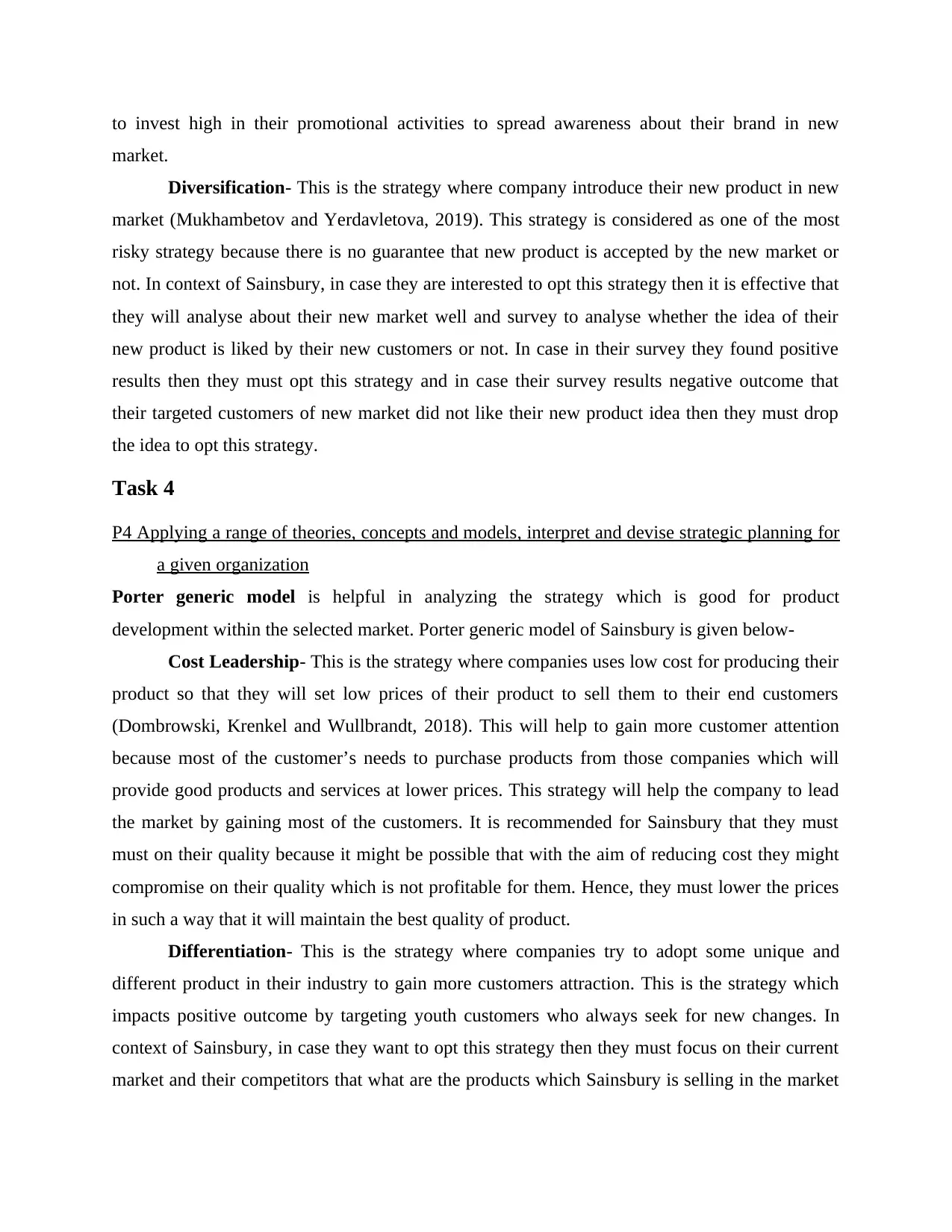
to invest high in their promotional activities to spread awareness about their brand in new
market.
Diversification- This is the strategy where company introduce their new product in new
market (Mukhambetov and Yerdavletova, 2019). This strategy is considered as one of the most
risky strategy because there is no guarantee that new product is accepted by the new market or
not. In context of Sainsbury, in case they are interested to opt this strategy then it is effective that
they will analyse about their new market well and survey to analyse whether the idea of their
new product is liked by their new customers or not. In case in their survey they found positive
results then they must opt this strategy and in case their survey results negative outcome that
their targeted customers of new market did not like their new product idea then they must drop
the idea to opt this strategy.
Task 4
P4 Applying a range of theories, concepts and models, interpret and devise strategic planning for
a given organization
Porter generic model is helpful in analyzing the strategy which is good for product
development within the selected market. Porter generic model of Sainsbury is given below-
Cost Leadership- This is the strategy where companies uses low cost for producing their
product so that they will set low prices of their product to sell them to their end customers
(Dombrowski, Krenkel and Wullbrandt, 2018). This will help to gain more customer attention
because most of the customer’s needs to purchase products from those companies which will
provide good products and services at lower prices. This strategy will help the company to lead
the market by gaining most of the customers. It is recommended for Sainsbury that they must
must on their quality because it might be possible that with the aim of reducing cost they might
compromise on their quality which is not profitable for them. Hence, they must lower the prices
in such a way that it will maintain the best quality of product.
Differentiation- This is the strategy where companies try to adopt some unique and
different product in their industry to gain more customers attraction. This is the strategy which
impacts positive outcome by targeting youth customers who always seek for new changes. In
context of Sainsbury, in case they want to opt this strategy then they must focus on their current
market and their competitors that what are the products which Sainsbury is selling in the market
market.
Diversification- This is the strategy where company introduce their new product in new
market (Mukhambetov and Yerdavletova, 2019). This strategy is considered as one of the most
risky strategy because there is no guarantee that new product is accepted by the new market or
not. In context of Sainsbury, in case they are interested to opt this strategy then it is effective that
they will analyse about their new market well and survey to analyse whether the idea of their
new product is liked by their new customers or not. In case in their survey they found positive
results then they must opt this strategy and in case their survey results negative outcome that
their targeted customers of new market did not like their new product idea then they must drop
the idea to opt this strategy.
Task 4
P4 Applying a range of theories, concepts and models, interpret and devise strategic planning for
a given organization
Porter generic model is helpful in analyzing the strategy which is good for product
development within the selected market. Porter generic model of Sainsbury is given below-
Cost Leadership- This is the strategy where companies uses low cost for producing their
product so that they will set low prices of their product to sell them to their end customers
(Dombrowski, Krenkel and Wullbrandt, 2018). This will help to gain more customer attention
because most of the customer’s needs to purchase products from those companies which will
provide good products and services at lower prices. This strategy will help the company to lead
the market by gaining most of the customers. It is recommended for Sainsbury that they must
must on their quality because it might be possible that with the aim of reducing cost they might
compromise on their quality which is not profitable for them. Hence, they must lower the prices
in such a way that it will maintain the best quality of product.
Differentiation- This is the strategy where companies try to adopt some unique and
different product in their industry to gain more customers attraction. This is the strategy which
impacts positive outcome by targeting youth customers who always seek for new changes. In
context of Sainsbury, in case they want to opt this strategy then they must focus on their current
market and their competitors that what are the products which Sainsbury is selling in the market
Paraphrase This Document
Need a fresh take? Get an instant paraphrase of this document with our AI Paraphraser
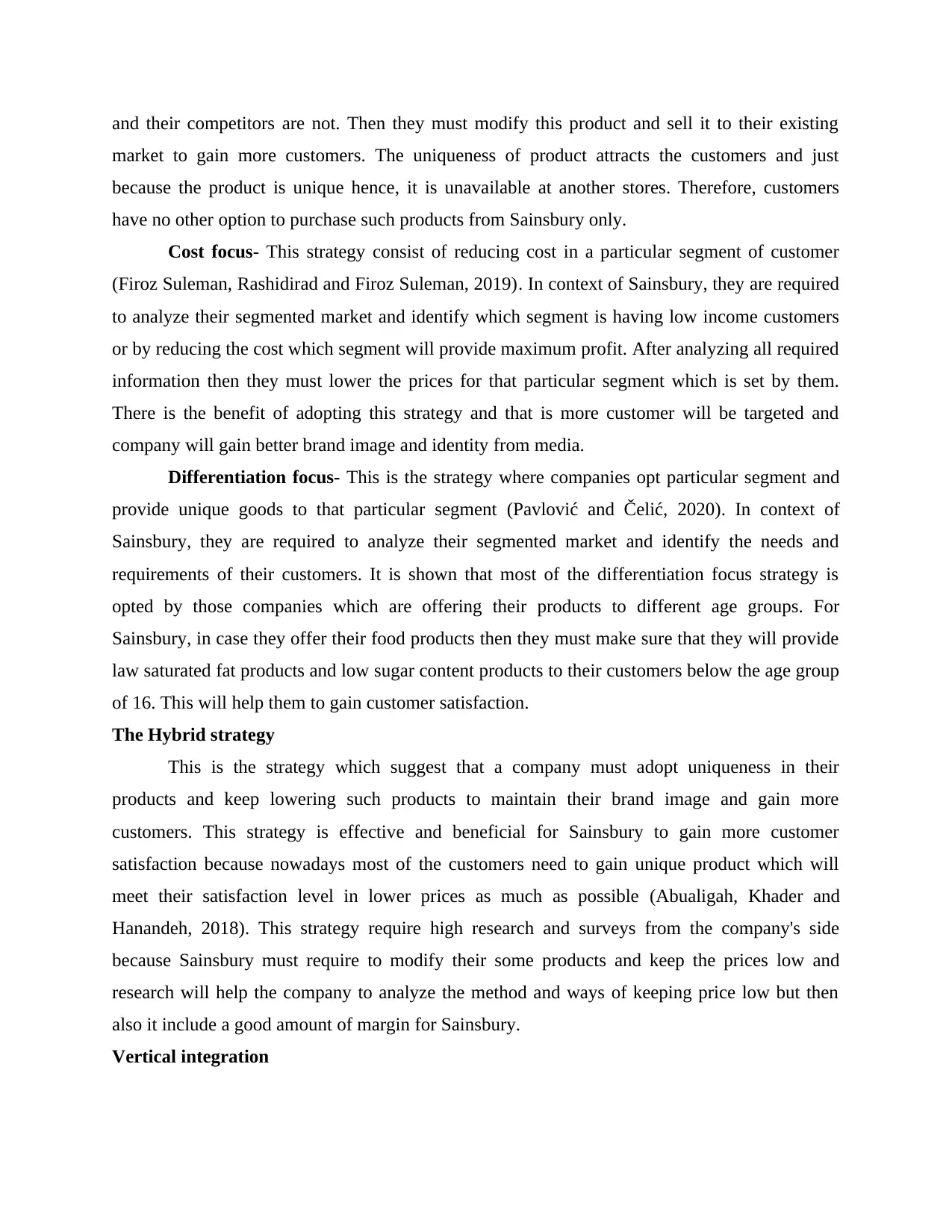
and their competitors are not. Then they must modify this product and sell it to their existing
market to gain more customers. The uniqueness of product attracts the customers and just
because the product is unique hence, it is unavailable at another stores. Therefore, customers
have no other option to purchase such products from Sainsbury only.
Cost focus- This strategy consist of reducing cost in a particular segment of customer
(Firoz Suleman, Rashidirad and Firoz Suleman, 2019). In context of Sainsbury, they are required
to analyze their segmented market and identify which segment is having low income customers
or by reducing the cost which segment will provide maximum profit. After analyzing all required
information then they must lower the prices for that particular segment which is set by them.
There is the benefit of adopting this strategy and that is more customer will be targeted and
company will gain better brand image and identity from media.
Differentiation focus- This is the strategy where companies opt particular segment and
provide unique goods to that particular segment (Pavlović and Čelić, 2020). In context of
Sainsbury, they are required to analyze their segmented market and identify the needs and
requirements of their customers. It is shown that most of the differentiation focus strategy is
opted by those companies which are offering their products to different age groups. For
Sainsbury, in case they offer their food products then they must make sure that they will provide
law saturated fat products and low sugar content products to their customers below the age group
of 16. This will help them to gain customer satisfaction.
The Hybrid strategy
This is the strategy which suggest that a company must adopt uniqueness in their
products and keep lowering such products to maintain their brand image and gain more
customers. This strategy is effective and beneficial for Sainsbury to gain more customer
satisfaction because nowadays most of the customers need to gain unique product which will
meet their satisfaction level in lower prices as much as possible (Abualigah, Khader and
Hanandeh, 2018). This strategy require high research and surveys from the company's side
because Sainsbury must require to modify their some products and keep the prices low and
research will help the company to analyze the method and ways of keeping price low but then
also it include a good amount of margin for Sainsbury.
Vertical integration
market to gain more customers. The uniqueness of product attracts the customers and just
because the product is unique hence, it is unavailable at another stores. Therefore, customers
have no other option to purchase such products from Sainsbury only.
Cost focus- This strategy consist of reducing cost in a particular segment of customer
(Firoz Suleman, Rashidirad and Firoz Suleman, 2019). In context of Sainsbury, they are required
to analyze their segmented market and identify which segment is having low income customers
or by reducing the cost which segment will provide maximum profit. After analyzing all required
information then they must lower the prices for that particular segment which is set by them.
There is the benefit of adopting this strategy and that is more customer will be targeted and
company will gain better brand image and identity from media.
Differentiation focus- This is the strategy where companies opt particular segment and
provide unique goods to that particular segment (Pavlović and Čelić, 2020). In context of
Sainsbury, they are required to analyze their segmented market and identify the needs and
requirements of their customers. It is shown that most of the differentiation focus strategy is
opted by those companies which are offering their products to different age groups. For
Sainsbury, in case they offer their food products then they must make sure that they will provide
law saturated fat products and low sugar content products to their customers below the age group
of 16. This will help them to gain customer satisfaction.
The Hybrid strategy
This is the strategy which suggest that a company must adopt uniqueness in their
products and keep lowering such products to maintain their brand image and gain more
customers. This strategy is effective and beneficial for Sainsbury to gain more customer
satisfaction because nowadays most of the customers need to gain unique product which will
meet their satisfaction level in lower prices as much as possible (Abualigah, Khader and
Hanandeh, 2018). This strategy require high research and surveys from the company's side
because Sainsbury must require to modify their some products and keep the prices low and
research will help the company to analyze the method and ways of keeping price low but then
also it include a good amount of margin for Sainsbury.
Vertical integration
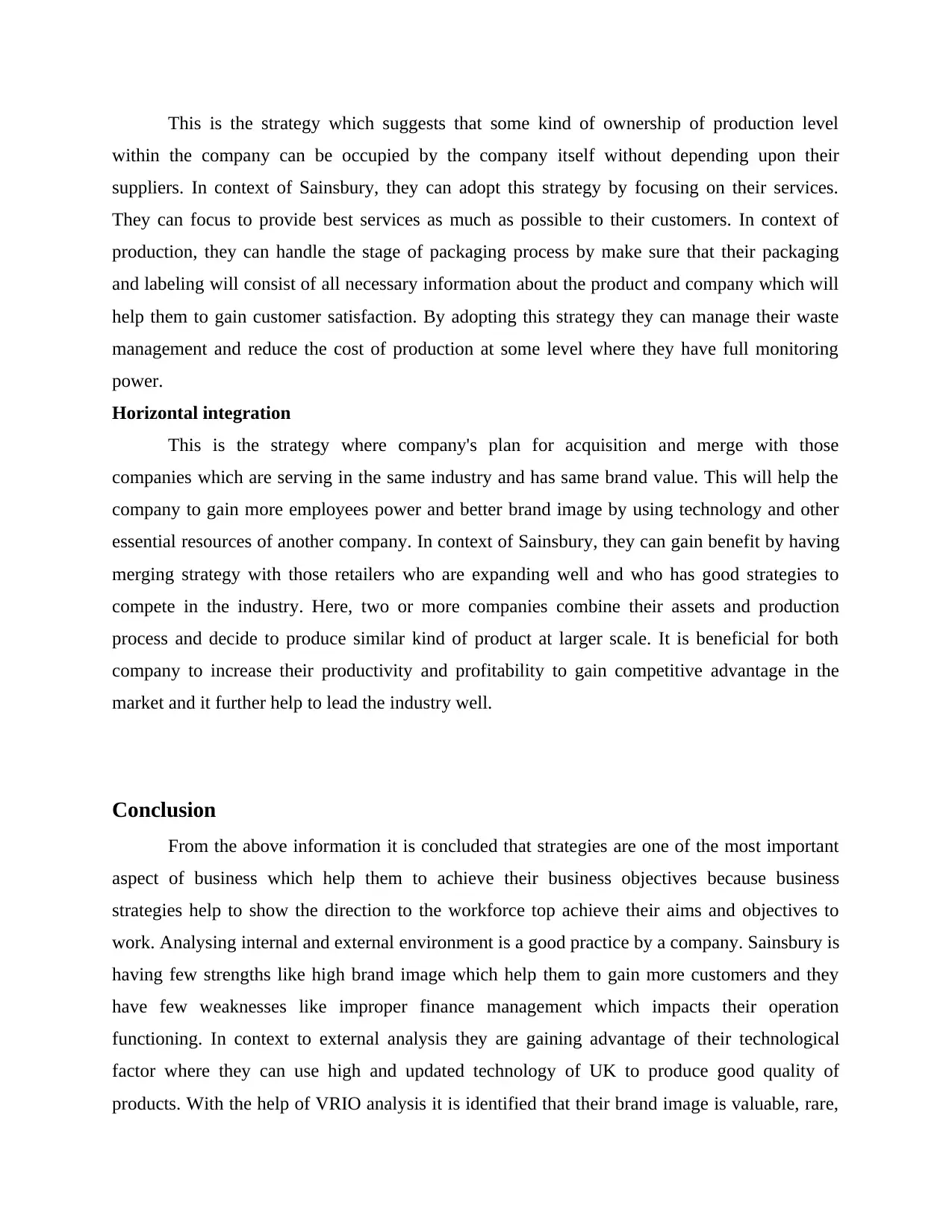
This is the strategy which suggests that some kind of ownership of production level
within the company can be occupied by the company itself without depending upon their
suppliers. In context of Sainsbury, they can adopt this strategy by focusing on their services.
They can focus to provide best services as much as possible to their customers. In context of
production, they can handle the stage of packaging process by make sure that their packaging
and labeling will consist of all necessary information about the product and company which will
help them to gain customer satisfaction. By adopting this strategy they can manage their waste
management and reduce the cost of production at some level where they have full monitoring
power.
Horizontal integration
This is the strategy where company's plan for acquisition and merge with those
companies which are serving in the same industry and has same brand value. This will help the
company to gain more employees power and better brand image by using technology and other
essential resources of another company. In context of Sainsbury, they can gain benefit by having
merging strategy with those retailers who are expanding well and who has good strategies to
compete in the industry. Here, two or more companies combine their assets and production
process and decide to produce similar kind of product at larger scale. It is beneficial for both
company to increase their productivity and profitability to gain competitive advantage in the
market and it further help to lead the industry well.
Conclusion
From the above information it is concluded that strategies are one of the most important
aspect of business which help them to achieve their business objectives because business
strategies help to show the direction to the workforce top achieve their aims and objectives to
work. Analysing internal and external environment is a good practice by a company. Sainsbury is
having few strengths like high brand image which help them to gain more customers and they
have few weaknesses like improper finance management which impacts their operation
functioning. In context to external analysis they are gaining advantage of their technological
factor where they can use high and updated technology of UK to produce good quality of
products. With the help of VRIO analysis it is identified that their brand image is valuable, rare,
within the company can be occupied by the company itself without depending upon their
suppliers. In context of Sainsbury, they can adopt this strategy by focusing on their services.
They can focus to provide best services as much as possible to their customers. In context of
production, they can handle the stage of packaging process by make sure that their packaging
and labeling will consist of all necessary information about the product and company which will
help them to gain customer satisfaction. By adopting this strategy they can manage their waste
management and reduce the cost of production at some level where they have full monitoring
power.
Horizontal integration
This is the strategy where company's plan for acquisition and merge with those
companies which are serving in the same industry and has same brand value. This will help the
company to gain more employees power and better brand image by using technology and other
essential resources of another company. In context of Sainsbury, they can gain benefit by having
merging strategy with those retailers who are expanding well and who has good strategies to
compete in the industry. Here, two or more companies combine their assets and production
process and decide to produce similar kind of product at larger scale. It is beneficial for both
company to increase their productivity and profitability to gain competitive advantage in the
market and it further help to lead the industry well.
Conclusion
From the above information it is concluded that strategies are one of the most important
aspect of business which help them to achieve their business objectives because business
strategies help to show the direction to the workforce top achieve their aims and objectives to
work. Analysing internal and external environment is a good practice by a company. Sainsbury is
having few strengths like high brand image which help them to gain more customers and they
have few weaknesses like improper finance management which impacts their operation
functioning. In context to external analysis they are gaining advantage of their technological
factor where they can use high and updated technology of UK to produce good quality of
products. With the help of VRIO analysis it is identified that their brand image is valuable, rare,
⊘ This is a preview!⊘
Do you want full access?
Subscribe today to unlock all pages.

Trusted by 1+ million students worldwide
1 out of 15
Related Documents
Your All-in-One AI-Powered Toolkit for Academic Success.
+13062052269
info@desklib.com
Available 24*7 on WhatsApp / Email
![[object Object]](/_next/static/media/star-bottom.7253800d.svg)
Unlock your academic potential
Copyright © 2020–2025 A2Z Services. All Rights Reserved. Developed and managed by ZUCOL.



